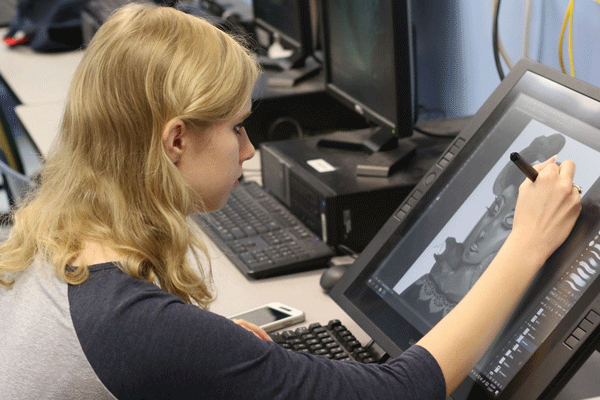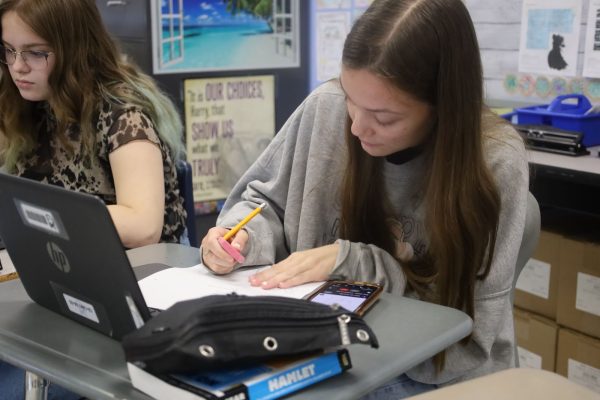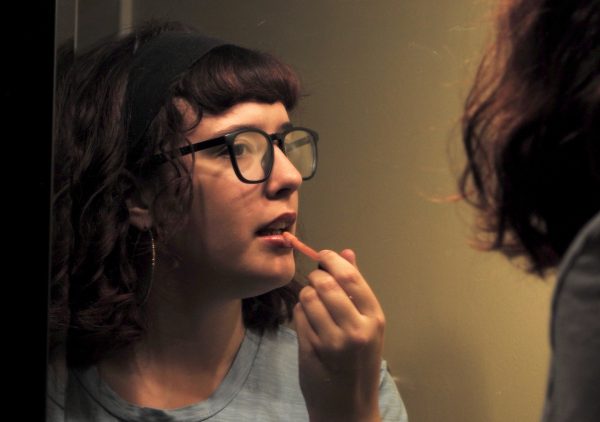A heart for the arts
Art education prepares students for future career paths

Senior Mackenzie Fitzgerald does online design work during her Digital Art class
For most people, the idea of a job in art is the idea of a starving artist, struggling to sell their work for pennies apiece. For some, its an ideal just out of reach or a dream they think is impossible. However, for some art students like seniors Porsha Martin and Mackenzie Fitzgerald , the reality is not so distant.
Martin and Fitzgerald have taken art for most of their lives, and after high school are planning to attend art school and go into an art-based career. Fitzgerald has already begun selling her art in a weekly art show put on by the Artistic Hand.
“Whenever you find something that you really love, and you know later in life you’re going to enjoy, you’re like, ‘That’s what I want to do,” Martin said.
For these students, art lessons have played an important role in their lives. Although the classes were intended to improve their skills, they also inspired them to pursue a career in an artistic field. Art-based careers exist in almost every field, many of which offer high pay. Jobs in architecture and graphic design require workers to use art skills while offering a comfortable pay check. An average architect makes $72,000 a year, well above the national average.
“For each design or simulation, there is an artist that has designed the character in animations, or the prototypes for toys or even cars,” art teacher Mary Marinel said. “Everything we come in contact with probably has had an artist help design it at some point.”
In 2D, 3D and digital art, students take time out of their day to learn technique and style, as well as practice the skills they have learned. Even for students who don’t want to pursue an art-related career, art can provide a respite from day to day monotony. Many students spend several class periods in academically focused classes, and a creativity based class like art can help encourage different styles of thinking. While art class can be educational and requires attention to detail, it can also give them an opportunity to spend some of their school time on something they love.
“I think it helps kids be creative, and gives them a break from thinking so mathematically,” Fitzgerald said.
Regardless of whether a student intends to pursue a career in art, this break can be beneficial. Participating in an art class has proven scientific benefits. In 2006, a study by the Solomon R. Guggenheim Museum showed that art education led to improved literacy skills, and a 2011 study by the President’s Committee on the Arts and the Humanities showed that integrating arts into other subjects can raise achievement levels. On a campus-wide level, The Center for Arts Education showed a connection between increased art education and decreased rates of student dropouts. Even former President Barack Obama believed in the importance of art, addressing it during a Presidential Proclamation about National Arts and Humanities month.
“Throughout history, the arts and humanities have helped men and women around the globe grapple with the most challenging questions and come to know the most basic truths,” Obama said.
Traditional visual art is not the only type of art that can help students. Depending on their interests, a student could take a class or pursue a career in many different creative fields, including dance, theatre and music.
While an artistic career, or even an artistic class may not be for everyone, others find the subject to be an integral part of their day, whether for career training or simply for self-expression.
“The whole time, I’ve known how much I’ve loved art, and how much art has affected my life and made me happier,” Martin said. “It’ just a good outlet to express myself.”
Your donation will support the student journalists of Hagerty High School. We are an ad-free publication, and your contribution helps us publish six issues of the BluePrint and cover our annual website hosting costs. Thank you so much!






